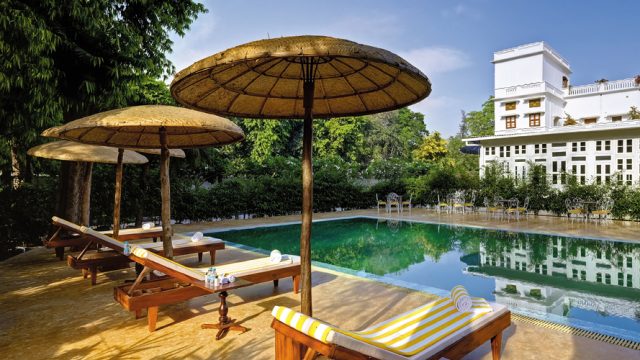The lebua Lucknow is the hottest place to be in the city. At this moment, in late January, with the fascinating drama of the Uttar Pradesh elections about to unfold, it’s where anyone with an interest in Indian politics might want to be. First, it’s located in what my cab driver informed me was a “VIP area”. I hadn’t paid much attention, till I nearly arrived. To nearly arrive is to drive past a fortification that could have been Mughal, except that it displays too much bad taste. Aha, Mayawati, not Mughal; similar intent, different effect.
The exquisite lebua Lucknow, Saraca Estate, is located across from the enormity that is the politician’s residence and the vaulting ambition that is her party headquarters. The UP Congress headquarters are down the road. This is all very interesting because I arrived just after the earthquake called demonetisation had hit the country, and the air was thick with chatter, annoyance, bluster and belief. (Cars lining up at midnight outside M’s house, allowed inside, because, you know, suitcases… AY is a good guy, he tries, but, you know, his father…. NM has done a great thing, of course the BJP will win… NM has done a terrible thing, the BJP cannot win…)
The heat and dust of Indian politics is best viewed from the vantage point of one of the beautiful verandahs of this hotel. Because the lebua is also the coolest joint in town. Astonishingly enough, it is one of only a couple of ‘heritage hotels’ in a city whose legendary culture, grace and graciousness is a virtual cliché. Owned by Lucknow boy-turned-NRI Mohammad Abdullah, and his wife Nayab, and managed by international boutique hotel chain, lebua, the story behind the hotel is a fascinating one of personal passion. But it isn’t necessary to know it to revel in this sprawled beauty.
Abdullah and Nayab are responsible for converting the 1936 haveli into an item of aesthetic perfection. I am the happy occupant of one of its nine suites (every room and suite is different). Mine is actually one large room, made larger by pushing one of the walls further onto a spacious verandah overlooking a green lawn dotted with old trees. (Sheila Dikshit’s favoured residence when visiting Lucknow is the suite just under mine.) The flooring, which I had noticed in pre-visit publicity pictures, had already caught my eye. It had acted as a sort of visual mnemonic for me of the city’s famed thing for beauty: I had first seen the jaali-pattern tiles in the Delhi home of a lady from Lucknow who has remained my ideal of beauty, refinement, elegance and a sort of aesthetic intellectualism for decades now. Don’t know what I’m talking about? Never mind, I’m merely saying that those yellow-and-white floor tiles did me in.

The same pattern is used to superb effect at various venues. The flooring of my room is part tile and part Jaisalmer stone, and the rug uses the jaali in grey and white. When I venture into the Azrak restaurant, I see it replicated in a spectacular turquoise tile with white motif in the indoor seating area with the reverse colour scheme outdoors. But to return to describing the splendours of my living quarters: the French windows through which bright sunshine pours, an inviting old-wood bed done with the best quality, bright-white bed linen with an emerald-green zardozi-worked throw for a touch of colour. A ceramic, not plastic or steel, kettle with a blue-and-white pattern reminiscent of fine Chinaware. This attention to detail can be seen virtually everywhere one’s eye lands, such as the stained glass-and-wood ‘cages’ that house that workaday necessity, the air-conditioner.
The bathroom is a site of intense visual pleasure too. Done in muted tones of beige, using a variety of stones and patterned tiles, it is equipped with the best fittings. The generosity of space and idea extends to the range of Forest Essentials toiletries (the packaging with delicate floral motifs in different colours seems custom-designed but turns out to be merely happy coincidence).
A narrow old staircase leads into the central courtyard around which the bungalow was built. It is now an inviting outdoor seating space, with red brick tiles underfoot and simple white-painted wrought-iron tables and chairs. Coffee, tea and snacks can be had here, as one gazes at old trees and creepers that the owners designed the space around. In the wraparound corridor are more touches, such as an old gramophone, defunct of course, but which cleverly hides a miniature music player that emits gentle melodies on demand.

Sehen, as the courtyard is named, is only for the use of hotel guests. But the two other dining spaces, the Italian restaurant, called 1936, and Azrak are now hip dining options for casual visitors too. I had a rather good mixed-mushroom salad at 1936, a good place to watch the beautiful people of Lucknow enjoy the new sensation of eating Italian food that an Italian may not disown. Azrak serves ‘royal’ Indian cuisine: from Awadh, Hyderabad and Lucknow. Serving sizes are generous too, as I discovered at both restaurants as well as the room-service fish and chips I treated myself to at the end of a day’s sightseeing. On which last subject, I am happy to recommend that you too use the services of Ajay Jain, proprietor of Waltz Tours & Travels (waltzindia.in), a proud and knowledgeable guide to this city of nawabs. Yes, Wajid Ali Shah, life’s splendid, when you’re in the right place at the right time. I was, and the time feels pretty right to return too.
The Information
Location 212 Saraca Estate, 19 Mall Avenue, Lucknow/14km from airport
Accommodation 11 executive rooms, 11 deluxe rooms, 11 luxury rooms, 9 lebua suites
Tariff ₹5,500-11,500
Contact 0522-2238333, lebua.com




